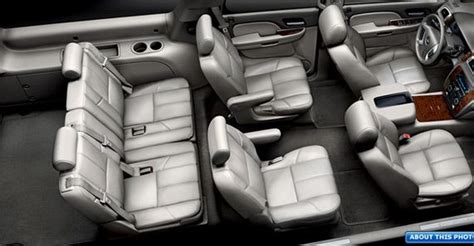
## Suburban Seating: Exploring the Optimal Number of Seats for Suburban Vehicles **Introduction:** Suburban vehicles are renowned for their spaciousness and versatility, often catering to families and individuals with active lifestyles. A key aspect of suburban vehicles is their seating capacity, which plays a significant role in determining their functionality and suitability for various purposes. This article delves into the factors that influence the optimal number of seats in suburban vehicles, considering aspects such as passenger comfort, cargo space, and specific usage scenarios. **Factors Influencing Seating Capacity:** **1. Family Size and Composition:** One of the primary factors to consider when determining the optimal number of seats in a suburban vehicle is the size and composition of the family. Larger families with multiple children may require a vehicle with more seating rows and a higher passenger capacity. On the other hand, couples or individuals may find a smaller suburban vehicle with fewer seats more suitable. **2. Passenger Comfort:** Seating capacity should also take into account passenger comfort. Suburban vehicles often undertake long journeys, making ample legroom, headroom, and seat width essential for ensuring a comfortable ride for all occupants. Cramped seating arrangements can lead to discomfort and fatigue, especially during extended trips. **3. Cargo Space Requirements:** The amount of cargo space available is another crucial factor to consider. Suburban vehicles are frequently used for transporting luggage, sports equipment, and other items. A vehicle with a larger cargo area may be necessary for families who regularly engage in outdoor activities or those who frequently transport large items. **4. Specific Usage Scenarios:** The intended use of the suburban vehicle also plays a role in determining the optimal seating capacity. If the vehicle is primarily used for daily commutes or school runs, a smaller suburban vehicle with fewer seats may suffice. However, if the vehicle is intended for camping trips, road trips, or transporting large groups of people, a larger suburban vehicle with more seating rows and a higher passenger capacity may be required. **5. Budgetary Considerations:** Budgetary constraints can also influence the choice of seating capacity. Larger suburban vehicles with more seating rows and features typically come with a higher price tag. Families or individuals with limited budgets may opt for a smaller suburban vehicle with fewer seats to stay within their financial means. **Popular Suburban Seating Configurations:** **1. Five-Seater Suburban Vehicles:** Five-seater suburban vehicles offer a balance between passenger space and cargo room. This configuration is suitable for small families or individuals who prioritize cargo space for outdoor activities or transporting large items. Examples include the Honda Pilot and the Toyota Highlander. **2. Seven-Seater Suburban Vehicles:** Seven-seater suburban vehicles provide additional seating capacity without compromising too much cargo space. This configuration is ideal for families with multiple children or those who frequently transport large groups of people. Popular seven-seater suburban vehicles include the Kia Telluride and the Hyundai Palisade. **3. Eight-Seater Suburban Vehicles:** Eight-seater suburban vehicles offer maximum seating capacity, accommodating up to eight passengers comfortably. This configuration is suitable for large families or those who frequently transport large groups of people. Examples of eight-seater suburban vehicles include the Chevrolet Suburban and the Ford Expedition. **Selecting the Right Seating Capacity:** Ultimately, the optimal number of seats in a suburban vehicle depends on individual needs and preferences. Families with multiple children or those who prioritize passenger comfort and cargo space may opt for a larger suburban vehicle with more seating rows. On the other hand, individuals or couples who prioritize fuel efficiency and maneuverability may find a smaller suburban vehicle with fewer seats more suitable. **Conclusion:** The seating capacity of a suburban vehicle is a crucial factor to consider when choosing the right vehicle for specific needs and preferences. Families, individuals, and those with active lifestyles should carefully evaluate factors such as family size, passenger comfort, cargo space requirements, specific usage scenarios, and budgetary considerations before making a decision. By selecting the optimal seating capacity, buyers can ensure a comfortable, functional, and enjoyable driving experience in their suburban vehicle.

